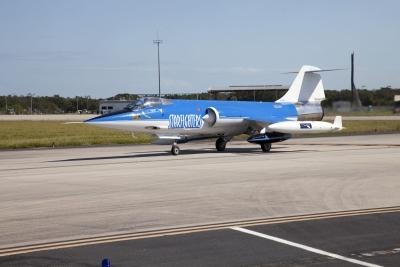Surplus Military Aircraft Evaluated As Potential Launch
Vehicles For Nanosatellites
Plans to launch small satellites into orbit from the wings of a
supersonic jet are moving along following a taxi test on the runway
at NASA's Kennedy Space Center in Florida.

The Starfighters, Inc. F-104 rolled to a stop Oct. 27 at the
Shuttle Landing Facility after the supersonic aircraft conducted a
high-speed taxi test. Piloted by Rick Svetkoff, the F-104 reached
speeds of 150 mph as it taxied up and down the runway. The test was
carried out to evaluate a newly developed suborbital vehicle that
has the potential to carry nanosatellites into low Earth orbit.
Commercial carriers like Starfighters, Inc., want to provide a
convenient, reasonably priced option for universities and
scientific institutions to build and launch missions.
Starfighters, Inc. of Clearwater, Fla., through a cooperative
Space Act Agreement, is based at the landing facility. This
business partnership furthers the research and development of
commercial space industries at Kennedy. Starfighter's fleet of
F-104 supersonic jets, similar to those NASA started using in the
1960's with Project Mercury, are helping usher in a new age of
commercial spaceflight.
The taxi test was conducted to verify the aeronautical
conditions of Star Lab. This is the first of eight tests the launch
vehicle will undergo. The final flight test will use a simulated
mock-up vehicle and will be flown over the Atlantic Ocean. After
the booster separates, a parachute will carry the payload for
splashdown. Sensors and recorders are encapsulated in each launch
vehicle tested and data will be analyzed for the build up to the
next test. 4Frontiers is aiming for tests to be completed by early
2012, with commercial flights starting mid-2012.
Star Lab has the potential to carry four to 13 payloads per
flight. 4Frontiers is hoping to launch 10 rockets per year with
multiple payloads, or more than 100 payloads per year. The company
is trying to keep the costs as low as possible and charges will
include flight integration and return of payload to owner.

The Star Lab suborbital launch vehicle tested was developed by
4Frontiers Corporation, a Florida company founded in 2005.
4Frontiers has commercially partnered with Starfighters, Inc.,
which will provide F-104 jets as flight platforms to air launch
Star Lab. 4Frontiers is an emerging space commerce business focused
on developing fundamental space-related capabilities and resources
essential for long-duration space flight.
The design and building of Star Lab is a collaborative effort
between 4Frontiers and students from Embry-Riddle Aeronautical
University and the University of Central Florida. The launch
vehicle was designed using funds awarded by the Florida Space Grant
Consortium. Star Lab supports scientific education for students by
offering a physical, hands-on learning environment. The launch
vehicle is designed by students and built by students.
The success of the launches of Star Lab has the potential to
open new avenues of research and education for scientists and
universities as demand for suborbital launch capability is expected
to grow.
The ultimate success of commercial flight projects like
Starfighters and 4Frontiers paves the way for expanding future use
of the Shuttle Landing Facility and furthers commercial research
flights from Kennedy.
 ANN's Daily Aero-Term (05.05.24): Omnidirectional Approach Lighting System
ANN's Daily Aero-Term (05.05.24): Omnidirectional Approach Lighting System Aero-News: Quote of the Day (05.05.24)
Aero-News: Quote of the Day (05.05.24) Airborne 05.06.24: Gone West-Dick Rutan, ICON BK Update, SpaceX EVA Suit
Airborne 05.06.24: Gone West-Dick Rutan, ICON BK Update, SpaceX EVA Suit Airborne 05.03.24: Advanced Powerplant Solutions, PRA Runway Woes, Drone Racing
Airborne 05.03.24: Advanced Powerplant Solutions, PRA Runway Woes, Drone Racing Aero-News: Quote of the Day (05.06xx.24)
Aero-News: Quote of the Day (05.06xx.24)




